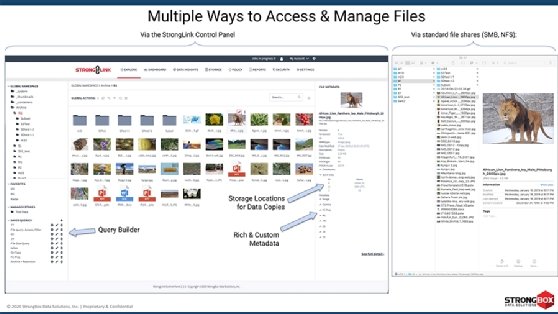
jro-grafik - Fotolia
StrongBox Data adds native LTFS to its StrongLink platform
With native support for any tape library, StrongLink is capable of cross-platform data management whether the underlying storage is flash, disk, tape or cloud.
StrongLink's new native Linear Tape File System (LTFS) feature shows that tape is very much alive and kicking.
The second generation of StrongBox Data Solutions' StrongLink software added faster performance when moving data at scale and introduced an optional LTFS feature that supports tape libraries from any vendor. This allows storage admins to set policies to automatically move data from primary storage to tape or any other storage, regardless of vendor or platform. StrongLink allows end users to access their files on a standard file share.
LTFS, also referred to as tape NAS, allows end users to index and access files stored on LTO tape similarly to the way they would access them on disk storage.
StrongLink data management software gives visibility across multiple storage silos through metadata-driven technology. Admins can manage all the files, either by setting policies to automate where and when to migrate them or manually dragging them between silos. Admins can also create and tag files with custom metadata on the fly for more granular management, and run queries and analytics through the StrongLink Control Panel. This can be done for all files across otherwise incompatible silos, such as in environments with multiple vendors or multiple public clouds.
StrongLink's use cases are data movement across heterogeneous storage, protection through replication and archiving, storage optimization and workflow automation.
The ability to automatically discover and be able to write to any tape library is important because of a renewed market demand for tape, StrongBox CEO Floyd Christofferson said. He said over the last couple of years, he's watched customers move from tape to cloud and then learn that the cloud was more expensive. Aside from these types of customers returning to tape, Christofferson pointed out that many cloud storage providers use tape to hold their massive volumes of data.

"You cannot beat the economics of tape," Christofferson said.
Marc Staimer, president of Dragon Slayer Consulting, said tape is still the best storage medium for archiving. Its combination of low cost, immutability, longevity and reliability makes it perfect for keeping infrequently accessed data for long periods. Data such as architectural blueprints or movies are examples of this.
"It's still a valid, valued storage medium. If you're archiving for the long term and not touching it, tape should be in your lexicon," Staimer said.
Staimer added that tape's backup use case has diminished. It was once viewed as a way to thwart ransomware because it creates an air gap, but cyber criminals today are targeting backup admin credentials, gaining access to backup systems and either setting retention policies to zero or changing the backup targets to their own servers.
Staimer has hands-on experience with StrongLink and described it as an impressive product. He said competitors such as Komprise have similar storage management and analytics capabilities, but StrongLink's ability to work across disparate storage silos without using agents, stubs or symlinks is unique. Staimer also said StrongLink was able to move 12 PB between an IBM LTFS appliance and a Spectra Logic BlackPearl storage system in an hour.
"The sheer volume of data it can move blows my mind," he said.
Staimer said data movement is one of the biggest difficulties in a data center. Moving old data out of primary storage is essential for cost savings and resource efficiency, but it requires knowing what the data is, what storage system it's on and how old it is. Staimer said most organizations don't have tools to gather this information, so they just keep their data on primary storage. Keeping infrequently accessed data on high-performance hardware is not cost-efficient, and increases the time it takes for backup systems to take snapshots.
Christofferson said StrongBox Data Solutions' smallest customers are in the 300 TB to 500 TB range, but most customers have a petabyte or more of data. These customers are most in need of low-cost long-term storage, which will either be on-premises tape or a cold tier of cloud storage such as Amazon S3 Glacier. He said StrongLink adds the most value for businesses with massive, complicated and continually growing data stores rather than organizations with one storage platform or fewer than 200 TB of data.
StrongLink is agentless and deployed on VMs or as an ISO. StrongBox prices StrongLink by subscription based on the number of cores it takes to move an organization's data.







